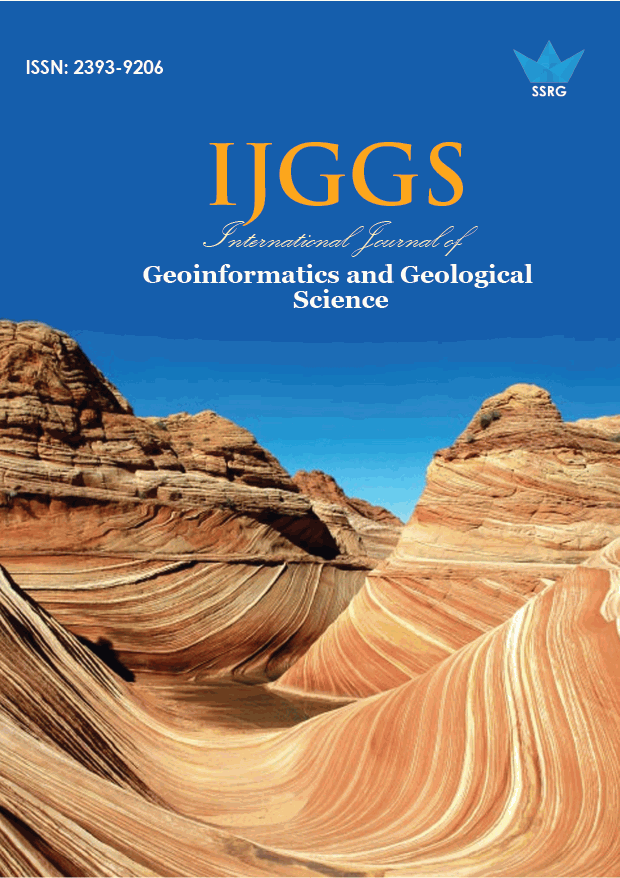Design, Construction And Performance Evaluation Of Soil Resistivity Meters At Six Geophysical Sites In Osustech, Okitipupa – Nigeria

| International Journal of Geoinformatics and Geological Science |
| © 2019 by SSRG - IJGGS Journal |
| Volume 6 Issue 3 |
| Year of Publication : 2019 |
| Authors : Gilbert A. Ibitola, Ojeleke A.Emmanuel, Olanrewaju Ajanaku, Abiola O. Ilori |
How to Cite?
Gilbert A. Ibitola, Ojeleke A.Emmanuel, Olanrewaju Ajanaku, Abiola O. Ilori, "Design, Construction And Performance Evaluation Of Soil Resistivity Meters At Six Geophysical Sites In Osustech, Okitipupa – Nigeria," SSRG International Journal of Geoinformatics and Geological Science, vol. 6, no. 3, pp. 24-30, 2019. Crossref, https://doi.org/10.14445/23939206/IJGGS-V6I3P104
Abstract:
This paper presents the design and construction of two soil resistivity meters that were tested at six different geophysical sites in Ondo State University of Science & Technology, (OSUSTECH) Okitipupa, Nigeria. In a related research work conducted by two Scientists, Igboama, W.N. and Ugwu, N.U., in the year 2011, a soil resistivity meter was designed and constructed. However, it was discovered that this soil resistivity meter was expensive, complex and not very accurate in its readings. It has been observed that the two soil resistivity meters designed and constructed (the serial
resistivity meter, SRM, and the parallel resistivity meter, PRM) in this research work are simple, low-cost and are of high accuracies. Their soil resistivity readings for the chosen six sites in Okitipupa, Nigeria compare favorably well with corresponding standard terrameter soil resistivity readings. The corresponding mean square errors and square mean errors in the soil resistivity measurements were found to be relatively small.
Keywords:
Accuracy, Errors, Geophysical Sites, Soil Resistivity Meter, Terrameter, Wenner.
References:
[1] Zhang, Y., Zuo, T., Cheng, Y. &Liaw, P. K. (2013). Highentropy Alloys with High Saturation Magnetization, Electrical Resistivity and Malleability. Scientific reports.
[2] Ingeman-Nielsen, T., Tomaškovičová, S. &Dahlin, T. (2016). Effect of Electrode Shape on Grounding Resistances—Part 1: The Focus-one Protocol. Geophysics, 81(1), WA159-WA167.
[3] Adepelumi A. A. & O. B. Akinmade, Fayemi. O. (2013). Evaluation of Groundwater Potential of Baikin Ondo State Nigeria Using Resistivity and Magnetic Techniques.
[4] OluwafemiOmowumi (2012). Electrical Resistivity Imaging Survey for Shallow Site Investigation at the University Ibadan
Campus Southwestern, Nigeria.
[5] Oyedele, K.F. &Ekpoette, K.U. (2011). Resistivity Attributes of Foundation Beds in a Sedimentary Terrain: Implications on Geo-Engineering Soil Conditions, Department of Geosciences, University of Lagos, Lagos, Nigeria.
[6] Adelusi, A. O., J. O. Amigun& B. D. Ako (2012). Integrated Geophysical Methods in Oil Sand Exploration in Agbabu Area of Southwestern, Nigeria.
[7] Nadler, A. (1982): Field Application of the Four-electrode Technique for Determining Soil Solution Conductivity, Soil Sc. Amer. J. 45:30-3A
[8] Rhoades, J.D., Manteghi, V., Shouse, P.J. & Alves, W.J (1989): Estimating Soil Salinity from Saturated Soil Paste Electrical Conductivity. Soil Sci. Soc. Am. J. 53:428-433.
[9] Edlefsen, N.E. & Anderson A.B.C. (1941): The Four Electrode Resistance Method for Measuring Soil Moisture Content Under Field Conditions. Soil Sci. Soc. Am. J.51:367-376.
[10] Kirkham, D. & Taylor, G.S., (1949): Some Tests of a Four Electrode Probe for Soil Moisture Measurements. Soil Sci.Soc. 14:42-46
[11] Banton, O., Segiun, M.K. & Cimon, M. A., (1997): Mapping Field-scale Physical Properties of Soil with Electrical Resistivity. Soil Sci. Soc. Am. J.61:1010-1017.
[12] Klasner, J. S. &Calengas, P. (2013). Electrical Resistivity and Soil Studies at Orendorf Archaeological Site, Illinois: A Case Study. Journal of Field Archaeology.
[13] Igboama, W. N. &Ugwu, N. U. (2011). Fabrication of Resistivity Meter and Its Evaluation. American Journal of Scientific and Industrial Research, 2(5), 713-717.

 10.14445/23939206/IJGGS-V6I3P104
10.14445/23939206/IJGGS-V6I3P104